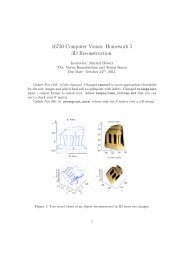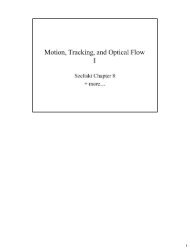16720: Computer Vision Homework 1
16720: Computer Vision Homework 1
16720: Computer Vision Homework 1
Create successful ePaper yourself
Turn your PDF publications into a flip-book with our unique Google optimized e-Paper software.
produces images in a common reference frame where all points in im1 and im2 are<br />
visible (a mosaic or panorama image containing all views) and out_size(2)==1280.<br />
M should be scaling and translation only, and the resulting image should fit snugly<br />
around the transformed corners of the images.<br />
2.3 Image blending<br />
Figure 2: Final mosaic view.<br />
Q2.6 Use the functions above to produce a panorama or mosaic view of the two images,<br />
and show the result. Save this image as q2_7.jpg. For overlapping pixels, it<br />
is common to blend between the values of both images. You can simply average the<br />
values. Alternatively, you can obtain a blending value for each image:<br />
mask = zeros(size(im,1), size(im,2));<br />
mask(1,:) = 1; mask(end,:) = 1; mask(:,1) = 1; mask(:,end) = 1;<br />
mask = bwdist(mask, ’city’);<br />
mask = mask/max(mask(:));<br />
The function bwdist computes the distance transform of the binarized input image, so<br />
this mask will be zero at the borders and 1 at the center of the image.<br />
Q2.7 In items Q2.1−2.3 we solved for the 8 degrees of freedom of a homography. Given<br />
that the two views were taken from the same camera and involve only a rotation, how<br />
might you reduce the number of degrees of freedom that need to be estimated?<br />
QX1 (Extra Credit 10 points) Assume that the rotation between the cameras is<br />
only around the y axis. Using H2to1, and assuming 4 no skew and α = β = 1274.4,<br />
4 The previous notation used α = fx, β = fy, u0 = cx, v0 = cy, and no skew.<br />
4







